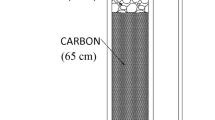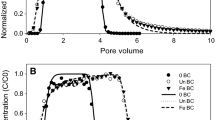Abstract
Three bench-scale rock filters containing 0.6 m of gravel were used in this investigation. Two of the filters were planted withSagittaria Iancifolia andScirpus validus, while the third filter was an unvegetated control filter. The wastewater directed through these systems was a synthetic mixture containing nutrient broth as the carbon source. An 80-day experiment was run on the filters using eight combinations of two flow rates and four influent biochemical oxygen demand (BOD5) concentrations, each combination remaining constant for ten days. These combinations resulted in BOD5 surface loadings from 4.63–30.96 g/day/m2. From other studies of batch and continuous flow rock-plant filter systems, the first-order BOD5 reaction rate constant was found to decrease exponentially with detention time. In this study, however, little correlation was found between BOD5 loading rate and removal percentages, which averaged 69%, 57%, and 47% for theScirpus, Sagittaria, and control systems, respectively. This is probably due to the relatively small change in detention times studied and the short time period of each loading rate. Oxidation/reduction potential (ORP) and dissolved oxygen (DO) measurements within these systems indicated that no free oxygen was available at any depth. Total Kjeldahl nitrogen (TKN) removal was higher in the plant systems relative to the control, with theScirpus system achieving a higher overall removal than theSagittaria system.
Similar content being viewed by others
References
American Public Health Association, American Water Works Association, and Water Pollution Control Federation: 1984,Standard Methods for the Examination of Water and Wastewater, 16th edition, Washington, D.C., American Public Health Association.
Armstrong, W.: 1964, ‘Oxygen Diffusion from the Roots of Some British Bog Plants’,Nature 204 (4960), 801–802.
Burgoon, P., DeBusk, T.A., Reddy, K.R., and Koopman, B.: 1991, ‘Vegetated Submerged Beds with Artificial Substrates. I: BOD Removal’,ASCE Journal of Environmental Engineering 117 (4), 394–407.
Bavor, H.J., Roser, D.J., Fisher, P.J., and Smalls, I.C.: 1989, ‘Performance of Solid-Matrix Wetland Systems Viewed as Fixed-Film Bioreactors’,Constructed Wetlands from Wastewater Treatment: Municipal, Industrial, and Agricultural, D.A. Hammer (Ed.), Lewis Publishers, Inc., pp. 646–656.
Brix, H.: 1990, ‘Gas Exchange Through the Soil-Atmosphere Interphase and Through Dead Culms ofPhragmites australis in a Constructed Reed Bed Receiving Domestic Sewage’,Water Research 24 (2), 259–266.
Findlater, B.C., Hobson, J.A., and Cooper, P.F.: 1990, ‘Reed Bed Treatment Systems: Performance Evaluation’,Constructed Wetlands in Water Pollution Control, P.F. Cooper and B.C. Findlater (Eds.), Pergamon Press, Oxford, U.K., pp. 193–204.
Gersberg, R.M., Elkins, B.V., Lyon, S.R., and Goldman, C.R.: 1986, ‘Role of Aquatic Plants in Wastewater Treatment by Artificial Wetlands’,Water Resources 20 (3), 363–368.
Lawson, G.J.: 1985,Cultivating Reeds (Phragmites australis) for Root Zone Treatment of Sewage, Project Report 965, Institute of Terrestrial Ecology, Cumbria, England.
Maddox, J.J. and Kingsley, J.B.: 1989, ‘Waste Treatment for Confined Swine with an Integrated Artificial Wetland and Aquaculture System’,Constructed Wetlands for Wastewater Treatment, D.A. Hammer (Ed.), Chelsea, Mich: Lewis Publishers, Inc., pp. 191–200.
Spangler, F.L., Sloey, W.E., and Fetter, C.W.: 1976, ‘Artificial and Natural Marshes as Wastewater Treatment Systems in Wisconsin’, presented at ‘Freshwater Wetlands and Sewage Effluent Disposal: Ecosystem Impacts, Economics, and Feasibility’, May 10–11, Univ. of Mich., Ann Arbor.
Trautmann, N.M., Martin, J.H., Porter, K.S., and Hawk, K.C.: 1989, ‘Use of Artificial Wetlands for Treatment of Municipal Solid Waste Landfill Leachate’,Constructed Wetlands from Wastewater Treatment: Municipal, Industrial, and Agricultural, D.A. Hammer (Ed.), Lewis Publishers, Inc., pp. 245–251.
Wolverton, B.C.: 1982, ‘Hybrid Wastewater Treatment System Using Anaerobic Microorganisms and Reed (Phragmites communis)’,Economic Botany 36 (4), 373–380.
Wolverton, B.C., McDonald, R.C., and Duffer, W.R.: 1983, ‘Microorganisms and Higher Plants for Wastewater Treatment’,Journal of Evnironmental Quality 12 (2), 236–242.
Wolverton, B.C.: 1987, ‘Aquatic Plants for Wastewater Treatment: An Overview’, inAquatic Plants for Water Treatment and Resource Recovery, K.R. Reddy and W.H. Smith (Eds.), Orlando, FL: Magnolia Publishing, Inc., p. 3.
Wood, A. and Hensman, L.C.: 1989, ‘Research to Develop Engineering Guidelines for Implementation of Constructed Wetlands in Wastewater Treatment in Southern Africa’,Constructed Wetlands for Wastewater Treatment, D.A. Hammer (Ed.), Chelsea, Mich: Lewis Publishers, Inc., pp. 581–589.
Author information
Authors and Affiliations
Rights and permissions
About this article
Cite this article
Skipper, D., Tittlebaum, M. A bench-scale rock-plant filter investigation. Environ Monit Assess 27, 69–80 (1993). https://doi.org/10.1007/BF02401765
Received:
Revised:
Issue Date:
DOI: https://doi.org/10.1007/BF02401765




